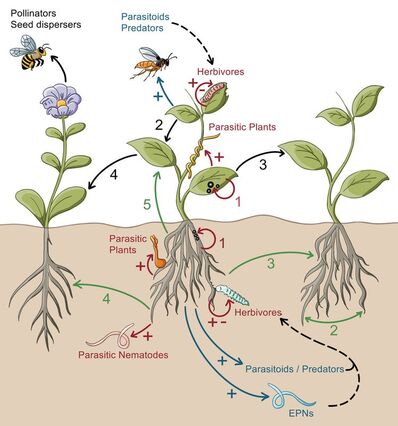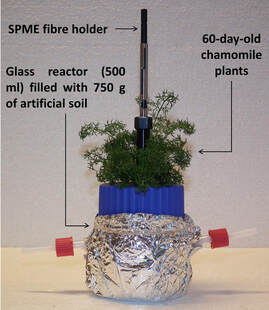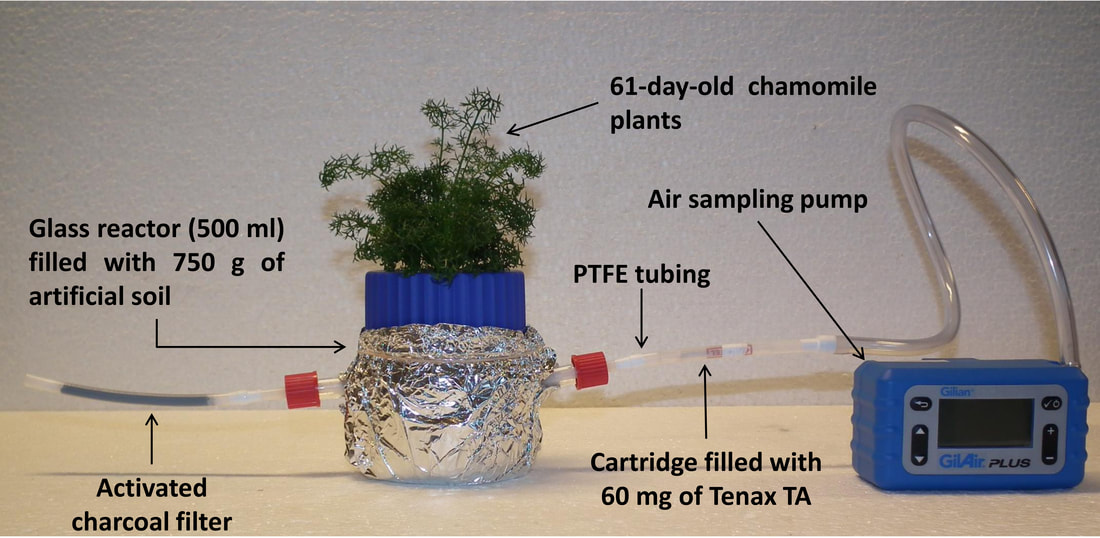A PhD story...
Since the beginning of my studies, I have always been very interested in plant-plant interactions and chemical ecology. This field of research was the perfect opportunity for me to combine different approaches I am interested in: plant ecology, plant physiology, and analytical chemistry. I started my PhD project in 2011 as a FNRS research fellow working at the University of Liège (Gembloux Agro-Bio Tech) under the supervision of Patrick du Jardin and Marie-Laure Fauconnier. My PhD work focused on the roles played by root-emitted volatile organic compounds (VOCs) in belowground plant-plant interactions. The main goals of this PhD thesis were to (1) identify and quantify the VOCs emitted by barley and chamomile roots and (2) study the influence of chamomile root volatiles on the growth and root system architecture of barley (interspecific model). After four years of work, I defended my PhD thesis in December 2015.
What are root VOCs?We are all very familiar with Volatile Organic Compounds (VOCs). In fact, we all meet them on a day-to-day basis when we perceive a (not so) pleasant smell in our environment: when we mow the lawn of our garden, when we walk in a forest or sit in a grassland, and even when we cook.
To be a VOC, a molecule needs to have two characteristics: it has to be organic and have a high volatility at ambient temperature. This broad definition includes many compounds from a wide variety of chemical families including terpenes, fatty acid derivatives, and isothiocyanates for instance. |
Plants are very good at synthesising VOCs. In fact, all plant organs are able to release VOCs into the atmosphere: flowers, fruits, leaves, and even roots! Thanks to the research of many chemical ecologists, we now know that plant-emitted VOCs play a very important role in mediating complex interactions between different parts of the same plant, between neighbouring plants, but also between plants, pathogens, and insects.
Above the soil surface, VOCs emitted by flowers and fruits act as a chemical cue attracting pollinators and seed dispersers. Another fascinating example is the ability of insect-attacked leaves to produce VOCs that will directly repel plant pests or attract natural enemies of the attacking herbivore, such as parasitoids for instance.
Plant roots are also able to synthesize and release VOCs into the rhizosphere (i.e., the zone of soil influenced by root activity). These VOCs play important roles in mediating belowground biotic interactions. For instance, VOCs emitted by roots can attract plant pests and other soil organisms such as nematodes and parasitoids that are able to prey on/feed on herbivores.
Surprisingly, we still know very little about the roles played by root-emitted VOCs in belowground plant-plant interactions. Can plants use root-emitted VOC cues to sense the presence of neighbours? Can VOCs emitted by plant roots affect the growth, biomass allocation, root morphology, and root system architecture of neighbours growing nearby? These are the questions I had in mind when I started my PhD. But before designing experiments to answer these questions, I had to face a relatively challenging task: how to trap and analyse VOCs emitted by undisturbed roots growing in the soil?
Above the soil surface, VOCs emitted by flowers and fruits act as a chemical cue attracting pollinators and seed dispersers. Another fascinating example is the ability of insect-attacked leaves to produce VOCs that will directly repel plant pests or attract natural enemies of the attacking herbivore, such as parasitoids for instance.
Plant roots are also able to synthesize and release VOCs into the rhizosphere (i.e., the zone of soil influenced by root activity). These VOCs play important roles in mediating belowground biotic interactions. For instance, VOCs emitted by roots can attract plant pests and other soil organisms such as nematodes and parasitoids that are able to prey on/feed on herbivores.
Surprisingly, we still know very little about the roles played by root-emitted VOCs in belowground plant-plant interactions. Can plants use root-emitted VOC cues to sense the presence of neighbours? Can VOCs emitted by plant roots affect the growth, biomass allocation, root morphology, and root system architecture of neighbours growing nearby? These are the questions I had in mind when I started my PhD. But before designing experiments to answer these questions, I had to face a relatively challenging task: how to trap and analyse VOCs emitted by undisturbed roots growing in the soil?
How can we analyse root VOCs?To be able to play a role in belowground biotic interactions, VOCs must reach a concentration high enough to induce a physiological response in a recipient organism (e.g., a plant neighbour). Therefore, the environmental fate of VOCs in the soil environment after their release from plant roots is of great importance.
Depending on their physico-chemical properties, VOCs can interact with the solid, liquid, or gaseous components of the soil system in many different ways, and the strength of these interactions will affect the distance over which root-emitted VOCs can travel. For instance, VOCs can be adsorbed into soil particle surfaces, used as a carbon source by microorganisms, solubilized into the soil solution, or diluted in the soil gaseous phase. If one wishes to investigate the implication of root volatiles in interplant signalling, being able to identify VOCs emitted by plant roots and quantify their actual emission rate in the soil environment requires the development of experimental devices and analytical methods allowing the sampling and analysis of VOCs emitted by unexcavated/undamaged root systems. This was one of the very first steps of my PhD! |
I used two complementary strategies to sample VOCs emitted by barley and chamomile roots. The first strategy consisted at sampling VOCs located in the soil gaseous phase by solid phase microextraction (static sampling). I only used this approach to screen and identify VOCs released by root tissues into the plants' rhizosphere. The second strategy consisted at pulling clean air out of a reactor containing soil and plant roots through a glass tube containing an adsorbent resin trapping volatile compounds (dynamic sampling). I mainly used this method to quantify the emission rate of barley and chamomile root VOCs. After sampling, VOCs were then separated by gas chromatography and analysed by mass spectrometry.


